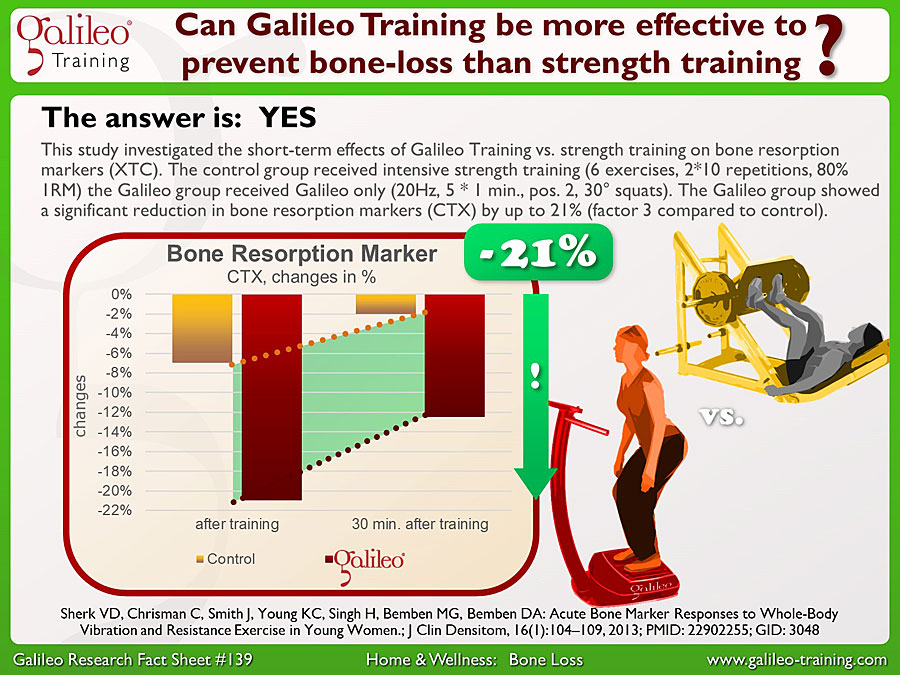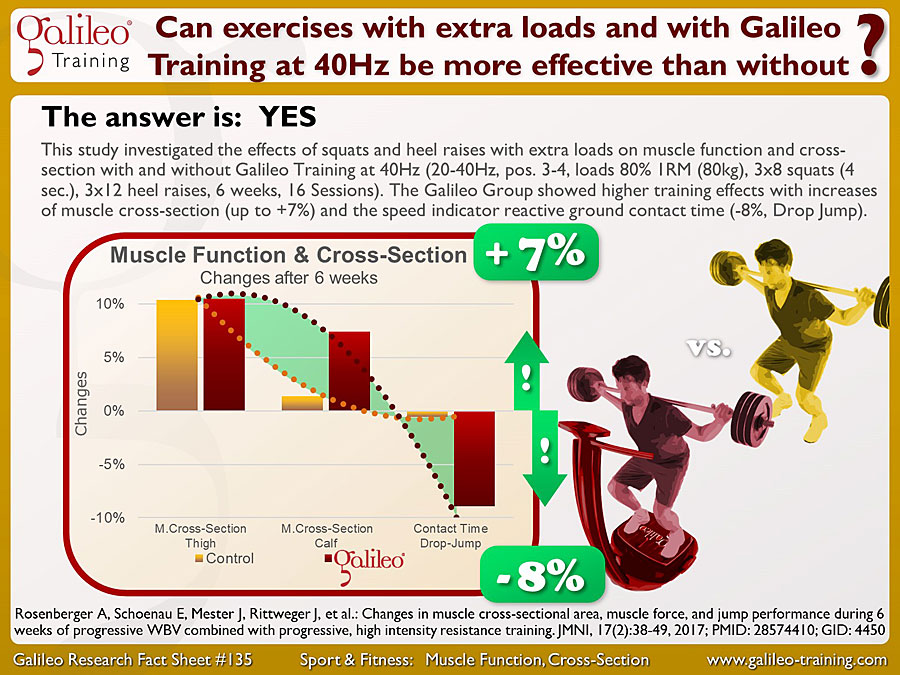In the 2nd Berlin Bedrest Study (BBR2) the effects of Galileo Training against the expected bone loss was tested (55 days, 24Hz, 6x1 min. exhaustive, 3/week). The control groups receive no training or identical training with-out vibration (RE). Compared to both control groups, the Galileo group showed a decrease in vertebra bone marrow fat fraction and in increase in number of red blood cells - both are related to increased endurance...
This study investigated the effects of squats and heel raises with extra loads on muscle function and cross-section with and without Galileo Training at 40Hz (20-40Hz, pos. 3-4, loads 80% 1RM (80kg), 3x8 squats (4 sec.), 3x12 heel raises, 6 weeks, 16 Sessions). The Galileo Group showed higher training effects with increases of isometric torque (up to +4%) and the speed indicator reactive ground contact time (-8%, Drop Jump)...
In the 2nd Berlin Bedrest Study (BBR2) the effects of Galileo Training against the expected bone loss was tested (55 days, 24Hz, 6x1 min. exhaustive, 3/week). The control groups receive no training or identical training with-out vibration (RE). While the control groups showed significant decrease in vascular parameters like dilator capacity or vascular diameter, the Galileo Group could even improve some of them (Vascular Stiffness)...
This study investigated the effects of 12 weeks of Galileo Training on bone formation markers and bone density of the spine in physical active students (age 18-23) (15-26Hz, 5-15 min., pos.2, 3/week, 12 weeks). The control group did not receive any additional exercises. While the control group decreased bone density at the spine of by up to 1.7%, the Galileo group could increase the bone density at the spine by up to 2.7%...
This study documented the immediate effects of Galileo Training one force development, torque and range of motion (ROM) (26Hz, 5x60s, stretching of ankle). The control group performed identical exercises without Galileo Mechanostimulation. The Galileo group showed increase stretching effects (+38%) and a significant increase in torque (Platarflexion) by +18%, and an increased force development at lower ankle angles (-7°)...
This study investigated the short-term effects of Galileo Training vs. strength training on bone resorption markers (XTC). The control group received intensive strength training (6 exercises, 2*10 repetitions, 80% 1RM) the Galileo group received Galileo only (20Hz, 5 * 1 min., pos. 2, 30° squats). The Galileo group showed a significant reduction in bone resorption markers (CTX) by up to 21% (factor 3 compared to control)...
This study investigated the warm-up effects of Galileo Training on muscle temperature, power and the training duration. Passive warm-up in a water bath (legs at 41°C), standard ergometer training (10 min., 70W) and Galileo Training (26Hz, Pos.3,10°-90° 6s slow dynamic squats, 5min.) where compared. The results showed that Galileo Training had higher effects on muscle power (ergometer) in a shorter time (52% of ergometer)...
This study investigated the effects of squats and heel raises with extra loads on muscle function and cross-section with and without Galileo Training at 40Hz (20-40Hz, pos. 3-4, loads 80% 1RM (80kg), 3x8 squats (4 sec.), 3x12 heel raises, 6 weeks, 16 Sessions). The Galileo Group showed higher training effects with increases of muscle cross-section (up to +7%) and the speed indicator reactive ground contact time (-8%, Drop Jump)...
This study investigated the immediate effects of Galileo Training on muscle tissue oxygenation and blood per-fusion (25Hz, 3 min., pos.2-3, 30° squats). The control group received squats (3 min, 12/min.) with additional weights matched to the VO2 values of the Galileo group. The Galileo group showed significantly higher muscle oxygenation of up to 2.4 times (+140%) starting right after the beginning and lasting longer than the exercise...
This study documented the effects of Galileo Training and concentric, eccentric and isometric knee torque in physical active young women (25Hz, pos.3, 2*5 min., 10° flexed legs, 5/week, 3 weeks). The control group continued their usual weekly training. The Galileo group received Galileo Training only. The Galileo group showed an improvement of knee torque by up to 16%. This effects was sustained even after 3 weeks (+7%)...









